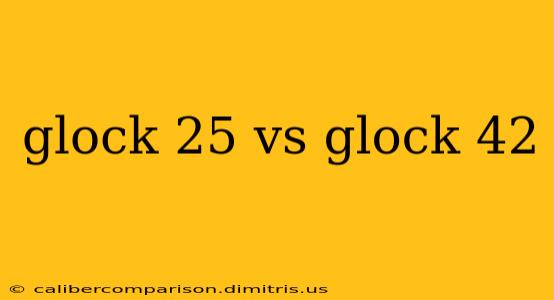Choosing the right concealed carry pistol is a deeply personal decision, heavily influenced by factors like hand size, shooting experience, and comfort level. The Glock 25 and Glock 42, both chambered in .380 ACP, are popular subcompact options, but they cater to slightly different needs. This in-depth comparison will help you determine which might be the better fit for you.
Key Differences: Size, Weight, and Grip
The most immediate difference between the Glock 25 and Glock 42 lies in their dimensions and weight. The Glock 25, while still compact, is noticeably larger and heavier than the Glock 42. This impacts concealability and ease of carry.
-
Glock 25: Offers a slightly larger grip, accommodating larger hands more comfortably. The extra weight can improve recoil management for some shooters. However, its increased size makes it less easily concealed than the Glock 42.
-
Glock 42: The Glock 42's defining feature is its incredibly slim profile. It's significantly smaller and lighter than the Glock 25, making it exceptionally easy to conceal, particularly for individuals with smaller hands or those seeking maximum concealment. The lighter weight, however, means more felt recoil for some users.
Recoil and Shootability
Both pistols are known for manageable recoil in the .380 ACP caliber, but the difference in weight significantly influences the shooting experience.
-
Glock 25: The added weight helps mitigate recoil, making it a potentially more comfortable option for those sensitive to recoil or new to firearms. The slightly larger grip also provides more control.
-
Glock 42: The lightweight nature of the Glock 42 contributes to a snappier recoil. While manageable, this might be more noticeable for less experienced shooters or those with smaller hands. Mastering the proper grip technique is crucial for effective shooting with the Glock 42.
Capacity and Features
While both pistols share the same caliber, they differ in magazine capacity.
-
Glock 25: Generally offers a higher magazine capacity than the Glock 42, providing more rounds per magazine. This can be a significant advantage in a self-defense situation.
-
Glock 42: Features a smaller magazine capacity due to its slim design. This trade-off is made for enhanced concealability.
Concealability and Carry
Concealability is the primary battleground for these two pistols.
-
Glock 25: While compact, its size and weight make it less ideal for deep concealment, perhaps better suited for appendix carry or an IWB holster.
-
Glock 42: The Glock 42 excels in concealability. Its slim profile allows for effortless concealment in a variety of carry methods, including pocket carry, making it a popular choice for everyday carry (EDC).
Which Glock is Right for You?
The "better" pistol depends entirely on individual needs and preferences.
-
Choose the Glock 25 if: You prioritize slightly better recoil management, higher capacity, and a more substantial grip. You might be a more experienced shooter or have larger hands.
-
Choose the Glock 42 if: Ultimate concealability is your top priority. You prefer a lightweight and exceptionally slim pistol, even if it means a snappier recoil and smaller capacity. This might be ideal for first-time concealed carriers or those with smaller hands.
Ultimately, the best way to decide is to handle both pistols, if possible, and assess which feels more comfortable and intuitive in your hand. Consider your individual needs, your level of shooting experience, and your preferred carry methods to make the most informed decision. Remember, safety and proper training are paramount when carrying any firearm.

